19 January 1778 Monday
Vases, Candelabra, Grave Stones, Sarcophagi. Tripods, Lamps and Ancient Ornaments volume I
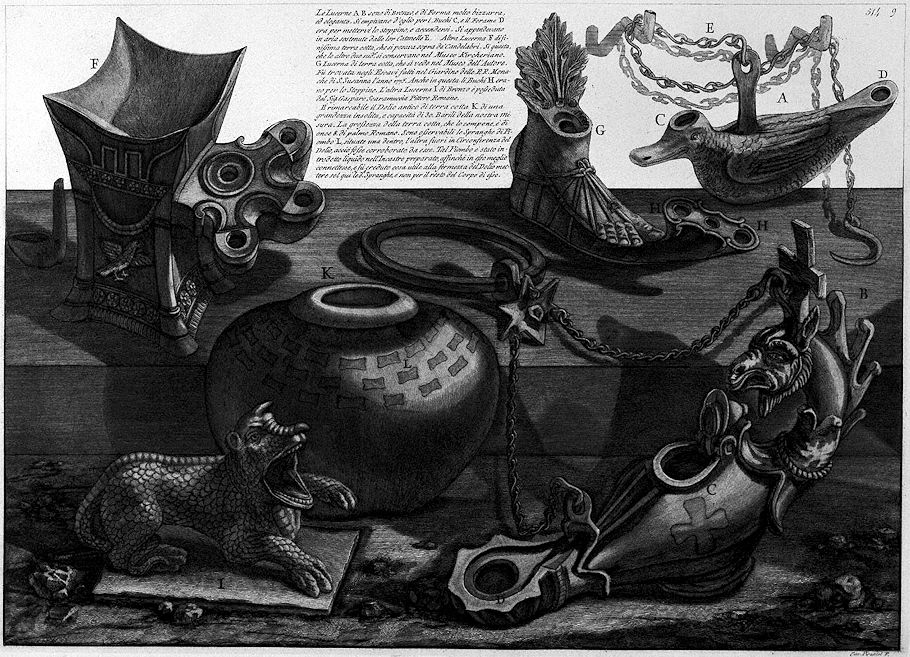
Five oil lamps and a terracotta dolium.
The Lucerne A B are of Bronze, and of a very bizarre and elegant shape. They were filled with oil through Holes C, and Foramen D was to put the wick in, and light up. They hung in the air supported by their chains E. Another lamp F of very fine terracotta, which was placed on top of the candelabra. Yes this one, that the other two south and are kept in the Kircherian Museum. G Terra cotta oil lamp, which can be seen in the Author's Museum. It was found in the Excavations made in the Garden of the R. R. Nuns of S. Susanna in the year 1775. Also in this one the Holes H were for the Wick. The other Bronze Lamp I is owned by Mr. Gaspare Scaramuccia Roman Painter.
The ancient terracotta Dolio K of an unusual size and capacity of 30 barrels of our size is remarkable. The thickness of the terra cotta, which composes it, is 8 ounces of Roman palm. The Spranghe di Piombo L can be observed, located one inside and the other outside in the Circumference of the Dolium, so that it could be corroborated by them. Such lead was introduced liquid into the prepared joint, so that it would connect better in it, and it was thought useful for the firmness of the Dolium to put only the spranghes here, and not for the rest of the body.
Cav. Piranesi F.
19 January 1812 Sunday
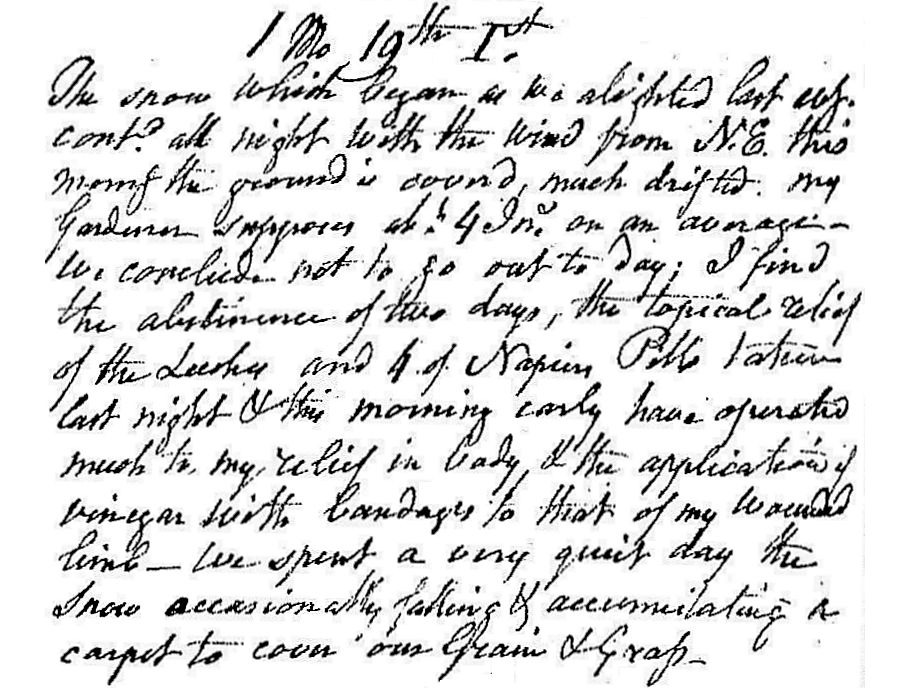
The snow which began as we alighted last evening continued all night with the wind from N.E. This morning the ground is covered, much drifted. My gardener supposes about 4 inches on average. We concluded not to go out today. I find the abstinence of two days, the topical relief of the leeches and 4 of Napirn[?] pills between last night and this morning early have operated much to my relief in body and the application of vinegar with bandages to that of my wounded limb. We spent a very quiet day. The snow occasionally falling and accumulating as carpet to cover our grain and grass.
19 January 2002
Re: lack of life
Sometime in the early 1970s I heard that the first friend of my life went missing, and then a month or so later her body was found in some South Carolina woods near where she and her family had moved to. Janet married quite young (I heard), and also divorced quite young. Her ex-husband was high on the suspect list.
While spending the summer of 1981 in Washington DC, I learned that Jim Williams shot Danny H. and that Jim was accused of murder. Here I knew (or at least met a few times) both the killed and the killer. You too might know the story by having either read or seen Midnight in the Garden of Good and Evil. In the years after jail in the early 1980s, Jim and I shared the same best friend, and thus I then had a closer than usual but still literally distant friendship with Jim. With all the stuff that I (and very few others) know, why aren't I busy trying to write the next record breaking best-seller? I even have copies of letters that Jim wrote while he was in jail, but somehow "laws of silence" unwittingly prevail. One of Jim's favorite phrases was "You don't know a thing." As far as I know, I'm the only person to have said "You don't know a thing" to Jim in the same way he used to say it to others. Another thing that is not generally known is that one of Jim's strongest motivations was to continually "Piss off the right people."
And then in (I think) 1986 Ismael Faruqi and his wife were brutally murdered in their Philadelphia suburban home. I was good friends with their architect-student niece, and even dated one of their daughters a couple of times (I know we at least saw Saturday Night Fever together). Faruqi was the last Palestinian governor of Galilee, and then head of the Religion Department at Temple University. I only learned of Faruqi's past political position after his death; I certainly didn't know it the night he drove me home after a late night charrette.
"And we become these human jukeboxes spitting out these anecdotes!" -- Six Degrees of Separation
Meanwhile (kind of) Theodosius is still lying in state at Milan, and "he's" going to be there for 38 more days. I have no idea why the laying is state is to take so long except that the total forty days may be some kind of reenactment of the forty days Christ spent in the desert, which is today reenacted annually via Lent. Perhaps this was somehow Ambrose's design, because it is interesting that after forty days, Ambrose should then deliver an obituary within which is the story of how the True Cross was found. [Get it? First Lent and then the Crucifixion.]
So, now that you have a fairly good idea of who Ambrose and Theodosius are, it is time to learn more of Honorius (the younger son of Theodosius who is now Emperor of the West) and his wife Maria. Honorius was the last ancient ruler to [re]build the walls of Rome (because of the "Gothic Wars"--Christian "Goths" that is) and he also built an imperial mausoleum attached to the original Basilica of St. Peter's. Sometime in the 1500s the sarcophagus of Maria was discovered (very likely while the old basilica was being demolished to make way for the new/present one). The sarcophagus of Maria may well be the last remaining substantial imperial artifact of (the city of) Rome, and after an illustrious title page and a frontispiece, it is an image of the sarcophagus of Maria that Piranesi uses to begin his Campo Marzio publication. In a most elegantly covert way, Piranesi began the 'history' of the Campo Marzio with what is really it's ending, and what is probably the world's greatest designed architectural inversionary double theater goes on from there.
Stephen Lauf
19 January 2003
abstract for Studium Urbis
...here's my abstract. I hope the formatting of the text comes through via email. If not, you can check quondam to see the format I intend. Thanks again for allowing me this opportunity to participate. I hope the abstract and the paper it portends meets your qualifications and expectations.
Steve
Mnemonically Delineating Veracity
"Authenticity is one thing, veracity another."
Marguerite Yourcenar, "Faces of History in the Historia Augusta" in The Dark Brain of Piranesi and other Essays.
An apparent lack of veracity has always been at issue within modern interpretations G. B. Piranesi's Ichnographia Campus Martius (1757-62) despite Piranesi's extraordinary 'scientific' knowledge of ancient Rome and it's remains as evident throughout the four volumes of Le Antichit� Romane (1756), as well as throughout Piranesi's other archaeological publications, including the Il Campo Marzio dell'Antica Roma. Contemporary architectural theorists from historian Manfredo Tafuri to architect Peter Eisenman view the Ichnographia as a city devoid of its own history, thus a plan prognosticating autonomous urbanism, yet that is exactly what the Ichnographia Campus Martius is not.
Beginning with comparisons between select portions of the Piranesi's Ichnographia and Giambattista Nolli's Pianta Grande di Roma, it becomes clear that the Ichnographia is an elaborate mnemonic devise. Like the imaginary building plans that Roman orators created in their minds as an aid toward the memorization of their speeches, the Ichnographia is literally an imaginary plan manifest as an aid toward the memorization of virtually all of ancient Rome's history. Thus the Ichnographia is not a fantastical reconstruction, rather, like the art of memory itself, the Ichnographia is a reenactment.
'Mnemonically Delineating Veracity' concludes with a brief reenactment of how an independent architect/artist from Philadelphia came to discover a heretofore unnoticed initial(?) printing of the Ichnographia Campus Martius.
Stephen Lauf
19 January2013
19 January
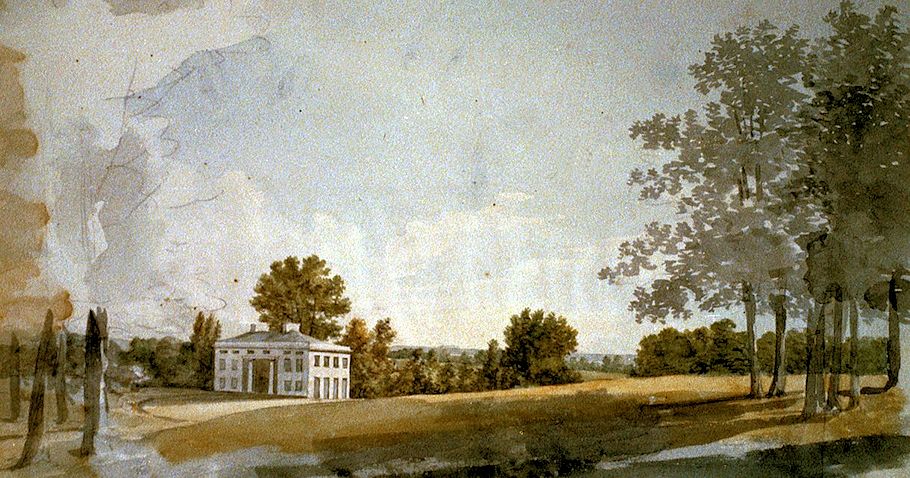
This [above] is what the place where I now live looked like about 202 years ago. It is a watercolor sketch of Ury House by Benjamin Henry Latrobe.
The sketch is presently within the Print and Photograph Division of the Library of Congress, where it is [mis]labeled as "Probably Long Branch, the Robert Carter Burnwell house, Clarke County, Va." But when you compare this watercolor to a 1824 sketch of "Miers Fisher's Place" by Charles Wilson Peale (who also painted a portrait of Latrobe)...
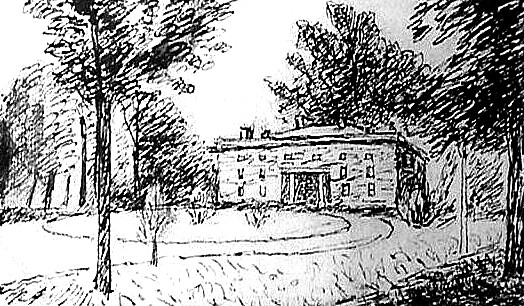
...the similarity of the two drawings is virtually exact. Plus, the ground contour of Latrobe's sketch matches Ury's.
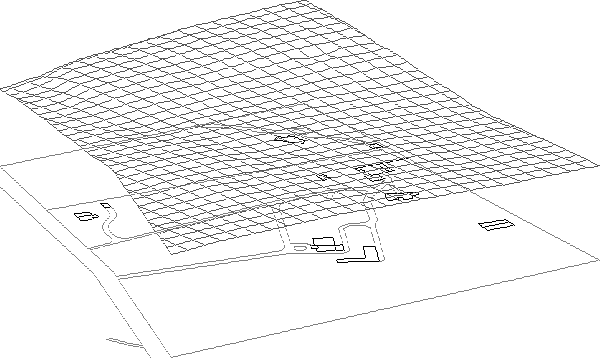
From The Papers of Benjamin Henry Latrobe (1994):
"Much more tentative is the possibility of alterations to the countryseat of Miers Fisher. In the 1812 annual exhibition at the Pennsylvania Academy of Fine Arts Latrobe submitted a "View of the Seat of Miers Fisher, Esq.," probably a watercolor. This was Ury, an old house some ten miles north of Central Philadelphia that Fisher had purchased in 1795 and added to "considerably." Latrobe's having drawn the house leads one to wonder if he might have played some professional role here."
Miers Fisher kept a copious daily journal throughout all his years of retirement at Ury. I have a copy of his 1812 journal, but there is no mention of Latrobe therein. I feel very confident now, however, that were I to go and get a copy of Miers' 1811 and 1810 journal, I'd find Latrobe mentioned there.
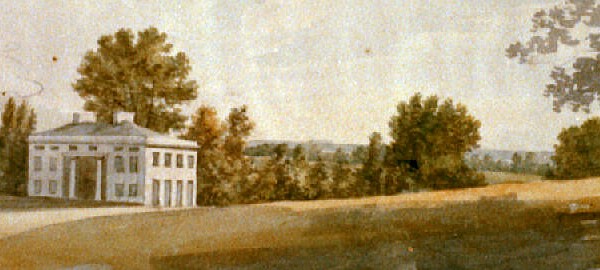
The much-further-altered Ury House was demolished 1973. The house I live in now is situated approximately just within the left side of the gap in the tree-line to the right. In fact, some of those very trees in the watercolor may still exist today (albeit in my neighbors' yards). When I look out the window next to where I'm sitting right now, a little slice of the distant horizon is still to be seen.
19 January 2021
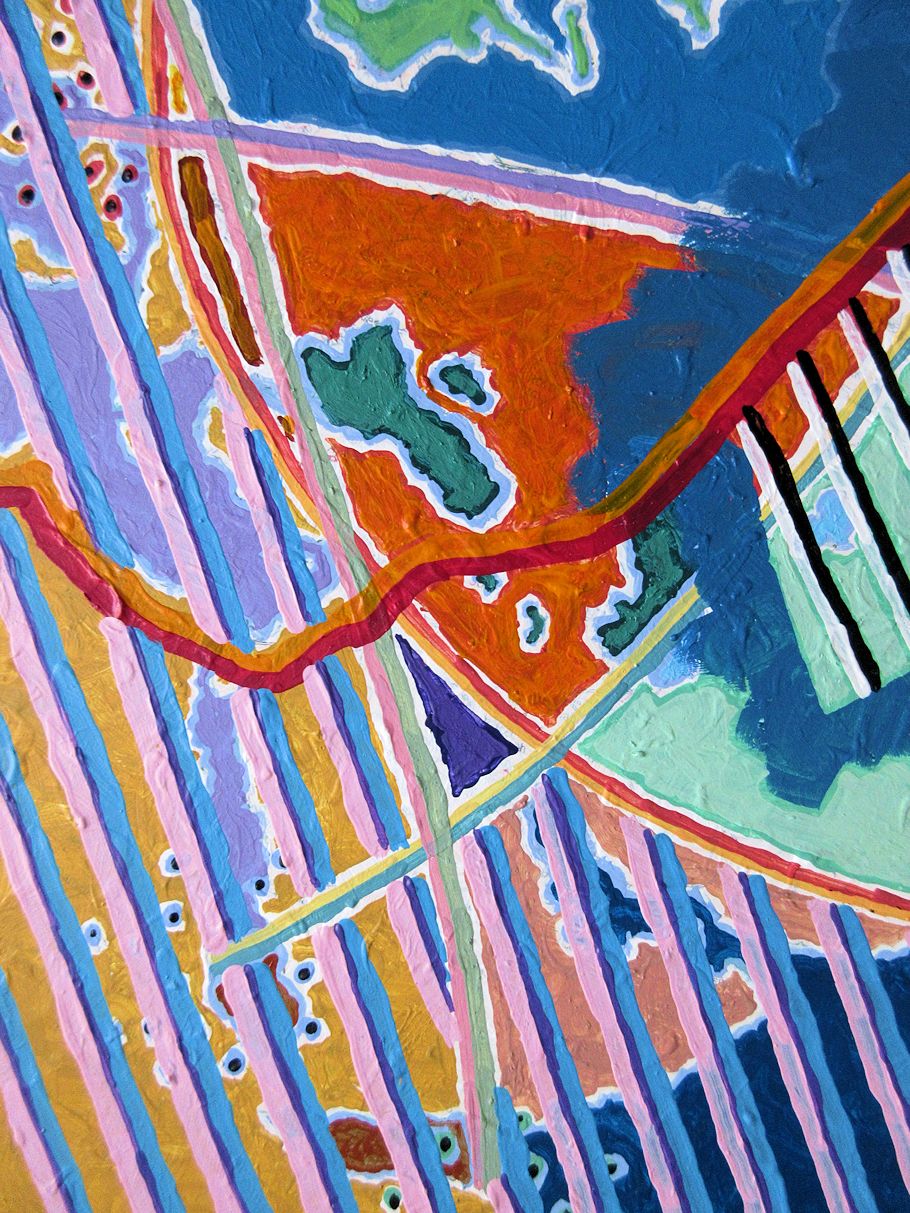
19 January 2023 Thursday
. . . . . .
|